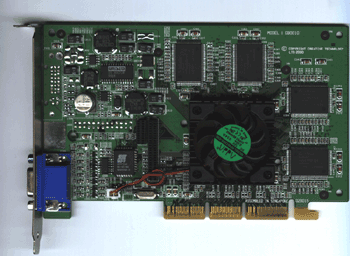
Original Link: https://www.anandtech.com/show/560
Creative Labs 3D Blaster Annihilator 2 GeForce 2 GTS
by Matthew Witheiler on June 9, 2000 10:38 AM EST- Posted in
- GPUs
 Since
the announcement of the GeForce 2 GTS processor from NVIDIA a little over a
month ago, we have been swamped with video cards based of this new GPU. With
the quick availability of the chip, it seems that almost every manufacturer
has jumped on the GeForce 2 GTS train at record speeds. NVIDIA proved that it
is no longer necessary to wait months before a product based on a new technology
is available to the consumer, as ELSA showed with the release of its GLADIAC
card 5 days after the GTS's announcement. The following weeks produced a slew
of GeForce 2 GTS based cards, each having its own unique selling point added
in an attempt to out feature and out sell the competition. This is easily reflected
by the current GeForce 2 GTS cards readily available now: the GLADIAC
features an impressive 6-year warrantee, Hercules/Guillemot adds RAM heatsinks
to its 3D Prophet II GTS to lure consumers, ASUS outfits the V7700
Pure with advanced hardware monitoring, and the Leadtek
WinFast GeForce 2 GTS sells extra cooling with its oversized heatsink.
Since
the announcement of the GeForce 2 GTS processor from NVIDIA a little over a
month ago, we have been swamped with video cards based of this new GPU. With
the quick availability of the chip, it seems that almost every manufacturer
has jumped on the GeForce 2 GTS train at record speeds. NVIDIA proved that it
is no longer necessary to wait months before a product based on a new technology
is available to the consumer, as ELSA showed with the release of its GLADIAC
card 5 days after the GTS's announcement. The following weeks produced a slew
of GeForce 2 GTS based cards, each having its own unique selling point added
in an attempt to out feature and out sell the competition. This is easily reflected
by the current GeForce 2 GTS cards readily available now: the GLADIAC
features an impressive 6-year warrantee, Hercules/Guillemot adds RAM heatsinks
to its 3D Prophet II GTS to lure consumers, ASUS outfits the V7700
Pure with advanced hardware monitoring, and the Leadtek
WinFast GeForce 2 GTS sells extra cooling with its oversized heatsink.
With all the power of the competition, how does Creative Labs, with its long awaited 3D Blaster Annihilator 2, plan on gaining any of this elusive market share? A quick glance at the card proves that there is nothing noteworthy on the surface, no toys, gizmos, or eye candy to make the card fly off the shelves. So how does this stealthy champion plan on attacking shelf space and enticing consumers?
The key is the price. With every other card retailing at a price of $350 a card, Creative Labs undercuts the competition by slashing prices. Would you believe that this GeForce 2 GTS based card will retail for $299? Well, it is true: the 3D Blaster Annihilator 2 will be the least expensive GeForce 2 GTS card out there by $50. On top of this, add the dominating market presence that only a 1.2 billion dollar company with more than 230 distributors can have, and you have an equation that ensures success. Or do you? In order to find out, we need to examine the 3D Blaster Annihilator 2 and determine if its low cost is a reflection of low quality or if Creative Labs does have a clear winner on their hands. To begin, let us look the the 3D Blaster Annihilator 2's specifications.
|
Key Features |
|
Powered
by the NVIDIA GeForce 2 GTS
|
|
Advanced
256-bit graphics architecture
|
|
AGP
4X with Fast Writes support
|
|
Integrated
high speed 350 MHz RAMDAC
|
|
32MB
of Double Data Rate (DDR) memory effectively operating at 333 MHz
|
|
5.3
GB/sec of dedicated graphics memory bandwidth
|
Features and Benefits:
- Powered by the GeForce 2 GTS - the worlds first gigatexel shading GPU from NVIDIA
- Advanced 256-bit graphics architecture
- AGP 4X with Fast Writes support
- Hardware full-scence anti-aliasing (FSAA)
- NVIDA Shading Rasterizer (NSR) - multi-operation single pass rasterizer
- 32MB of Double Data Rate (DDR) memory effectively operating at 333 MHz
- 5.3 GB/sec of dedicated graphics memory bandwidth
- Four independent pixel pipelines capable of rendering up to 8 texels per clock cycle to deliver fill rates of up to 1.6 Gigatexels per second
- 2nd-generation transform and lighting (T&L) engines processes up to 25 million triangles per second
- Optimized Direct3D and OpenGL acceleration with comprehensive support
- Advanced per-pixel, perspective-correct texturing including per-pexel shading and lighting, cube environment mapping, per-pixel bump mapping, light and reflection maps and texture compression (DXTC, S3TC)
- High performance 2D, GUI, and DirectDraw
- Screen resolutions of up to 2048x1536 optimized for 32, 16 and 8-bit per pixel color depths
- Flicker free refresh rates up to 240Hz
- Video Advanced digital video processing for DirectShow, MPEG1, MPEG2
- Enhanced motion compensation for full screen, full motion video playback
- Multi-tap bilinear video scaling and filtering
- Multiple video windows with hardware color space conversion and filtering
- DVD sub-picture alpha blended compositing
- Software bundle includes:
- Enhanced BlasterControl 4.0
- LAVA! Music Video Player
- Media Ring Talk
- E-Color Colorific
- 3Deep
- GeForce 2 GTS Demo
|
Refresh Rate Support |
||
|
Resolution |
Color |
Max Refresh Rate (Hz) |
|
640 x 480 |
256/65K/16M |
60 - 240 |
|
800 x 600 |
256/65K/16M |
60 - 240 |
|
1024 x 768 |
256/65K |
60 - 240 |
|
1024 x 768 |
16M |
60 - 200 |
|
1152 x 864 |
256/65K |
60 - 200 |
|
1152 x 864 |
16M |
60 - 170 |
|
1280 x 960 |
256/65K |
60 - 170 |
|
1280 x 960 |
16M |
60 - 150 |
|
1280 x 1024 |
256/65K |
60 - 170 |
|
1280 x 1024 |
16M |
60 - 150 |
|
1600 x 900 |
256/65K |
60 - 150 |
|
1600
x 900
|
16M
|
60
- 120
|
|
1600
x 1200
|
256/65K
|
60
- 120
|
|
1600
x 1200
|
16M
|
60
- 100
|
|
1920
x 1080
|
256/65K
|
60
- 100
|
|
1920
x 1080
|
16M
|
60
- 85
|
|
1920
x 1200
|
256/65K
|
60
- 100
|
|
1920
x 1200
|
16M
|
60
- 85
|
|
1920
x 1440
|
256/65K
|
60
- 85
|
|
1920
x 1440
|
16M
|
60
- 75
|
|
2048
x 1536
|
256/65K
|
60
- 75
|
|
2048
x 1536
|
16M
|
60
|
The Card
As stated before, unlike previous GeForce 2 GTS cards we have seen roll into the lab, the 3D Blaster Annihilator did not have the eye candy we have become accustomed to seeing on GeForce 2 GTS cards. No fancy cooling, no advanced video capture chips, no precise hardware monitoring. On the surface, the 3D Blaster Annihilator looks identical to the reference design. Boy, how looks can be deceiving.
The board layout and component configuration is nearly indistinguishable from the other GeForce 2 GTS cards we have received in the lab. Although these other cards may have larger heatsinks or other additional features, underneath all that glitter is the standard NVIDIA reference design. The 3D Blaster Annihilator 2 features the video out pin header that is missing on some other GeForce 2 GTS cards, meaning that perhaps someday a video out module will be available for the Annihilator 2. The heatsink, the standard 4.5 x 4.5 cm reference design heatsink, is attached to the cooling running GeForce 2 GTS GPU by means of thermal glue. Normally we would scoff at such bonding methods, however we showed in our Overclocking the GeForce 2 GTS guide that GPU heat produced by the core is negligible, meaning that cooling methods are coming in second when it comes to overclocking: card construction and chip quality seem to take the lead, a fact further discussed in the Overclocking section.
The 3D Blaster Annihilator 2 features the same 6ns (166 MHz) Infineon SGRAM chips found on all other DDR cards we have seen since the arrival of the GeForce 256 DDR. As we have said time and time again, it seems that Infineon is the only company currently producing DDR SGRAM chips for use in graphics cards, meaning that long gone are the days where RAM brand varied not only from company to company but also from card to card. You can also feel safe a bit longer knowing that the 6ns speed rating is the fastest SGRAM chips that Infineon currently manufactures, however their roadmap calls for 5.5 and 5ns RAM speeds in the future.
Basically, that is all there is to the 3D Blaster Annihilator 2. The lack of unnecessary eye candy is one method that Creative Labs used to keep the price of the card down. While the lack of features may seem as if they would deter the performance of the card, the Overclocking section proves that this is not the case. Read on and let us find out why.
Overclocking
In our quest to push the GeForce 2 GTS to its limits, we have seen cards come and go. The vast majority of these cards, no matter what cooling method or additional feature, would max out at an overclocked speed of about 232 MHz in the core. These cards showed a wide variation in cooling methods, from the huge heatsink of the Leadtek WinFast GeForce 2 GTS to the thermally glued heatsink/fan of the ELSA GLADIAC, proving that there must be something more behind overclocking the GeForce 2 GTS. This left two other variables dictating overclockabilty: chip quality and card design.
Chip quality, as discussed in our Overclocking the GeForce 2 GTS Guide, is a result of transistor conductivity, a function of the ratio between the transistor length and width. Since both transistor length and width vary during the manufacturing process, chip quality varies. A chip of "good" quality may be an excellent overclocker, while one made at the same plant may be deemed "poor" quality and overclock to a very small extent. Most chips fall in the middle range, meaning that most GeForce 2 GTS chips are capable of overclocking to some extent. The problem is that neither card manufacturer nor the product consumer can know if the chip they have received is of "good" quality. Therefore, this part of the overclocking game is luck.
Card design, on the other hand, seems to be the only avenue left that manufacturers can take to ensure good overclocking success. Since every GeForce 2 GTS card we have seen is based on NVIDIA's reference design, the aspect of card design we are referring to are the components used in the card. By using higher quality components and ensuring that the core receives a good power signal, card designers can choose to produce a card that is more stable and more overclockable than competing cards. Many times, manufacturers choose to cut corners here, using lesser quality components to cut cost. With the low $299 price tag on the 3D Blaster Annihilator 2, one would assume lower quality components were used to help bring the cost down. We are glad to report that this is not the case at all.
Despite the overclocking method described in our Overclocking the GeForce 2 GTS Guide, we did not choose to overclock the RAM to the highest possible speed and then increase the memory core because this method of overclocking does not stress the card design itself, but rather it only stresses the quality of the RAM chips used. For this reason, when we overclocked the our 3D Blaster Annihilator 2 (using the procedure described on page 5 of our Overclocking the GeForce 2 GTS Guide), we overclocked both the core and the memory speeds together. What this resulted in shocked us and spread a smile across our faces.
The Creative Labs 3D Blaster Annihilator 2 was able to obtain both core and memory speeds never yet seen in the GeForce 2 GTS. Using NVIDIA's built in tweak tool we slowly pushed the card higher and higher until we could not overclock anymore. However, unlike our past experiences, this time we were limited not by the card but by NVIDIA's drivers! That is right, for the first time in AnandTech history, and very well for the first time in any major stock card review, we were able to push the GeForce 2 GTS core up to a blazing 250 MHz. Using a bit of simple mathematics (250 MHz x 4 pipelines x 2 textures per clock), we were able to calculate that the card was actually running at 2 Gigatexels per second, making it "AnandTech's first 2 Gigatexel Game Accelerator," as the marketing slogan goes. This is up from the 1.6 Gigatexels per second that the stock GeForce 2 GTS does.
As we proved in our Overclocking the GeForce 2 GTS Guide, there is more to overclocking the GeForce 2 GTS than just its core: memory clock speed plays a vital role in maximum speed. Luckily, we were equally impressed with the maximum memory speed at such a high core speed. Our 3D Blaster Annihilator 2 was able to run completely stable at a 395 MHz memory clock speed, 62 MHz above the stock memory speed. Every bit of this memory speed is needed with such a blazing fast core, and, as our tests show, the 3D Blaster Annihilator 2 was able to use every last bit of that precious memory bandwidth.
Keep in mind that the overclockabilty of our card may not be typical of other 3D Blaster Annihilator 2 cards. Naturally, your mileage may vary. It is possible that our card just can with an exceptionally good quality chip and that other 3D Blaster Annihilator 2 cards are bound to overclock differently (however the fact that the card would allow the chip to run at this speed does show the good quality of the card).
The Drivers - FastTrax
Unique for Creative Labs, in fact unique for any video card we have seen, the 3D Blaster Annihilator 2 actually ships with 2 driver sets: the FastTrax drivers (described in this section) and the 3D Blaster Control drivers (described in the next section)
The FastTrax drivers are for those users "concerned with having the control panel flexibility and the fast development offered by FastTrax with Display Director ." Basically, the FastTrax drivers are the most recently updated NVIDIA drivers packaged into a unique interface designed by Creative Labs. This interface, which is more thrown together than the elegant 3D Blaster Control drivers, maintains the same functionality as the reference drivers but also adds a few additional features. The FastTrax drivers are designed around the idea that the backend of the drivers can be updated almost immediately after new NVIDIA reference drivers are released while still maintaining the custom interface. Basically, FastTrax updates will be frequent and match the pace of NVIDIA driver updates simply because the FastTrax system is easy for Creative Labs to update.
The drivers
contain pretty much everything we are used to seeing in the NVIDIA reference
driver set (OpenGL, D3D, and color tweaking screens), but Creative Labs also
throws in a few extra utilities. We were pleased to find an overclocking screen
(albeit it would only allow for a 220 max core speed, 30 MHz shy of what were
able to get the card to) as well as an AGP tweaking screen. On
the bright side, a hidden feature from Creative Labs allows the user to set
the maximum overclocked speed by double clicking on the end of the clock sliders,
meaning that the 220 number can be pushed as high as 250.
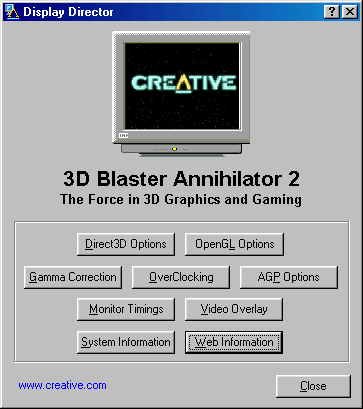
The main control screen.
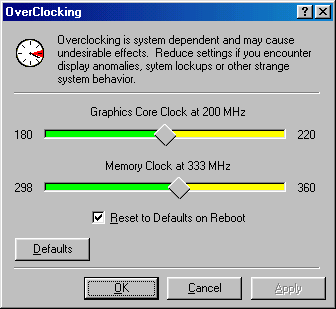
If we would have used this overclocking utility, we would have not gotten close
to our maximum overclocked speed. A nice feature, nonetheless.
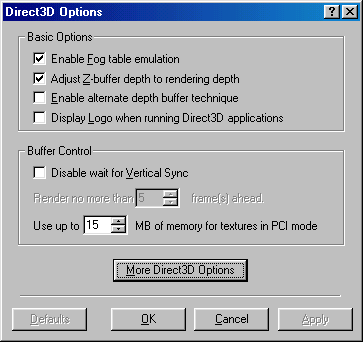
A standard D3D screen, with the same functionality as the reference drivers.
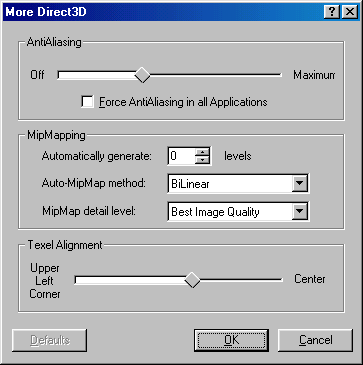
The D3D AntiAliasing screen.
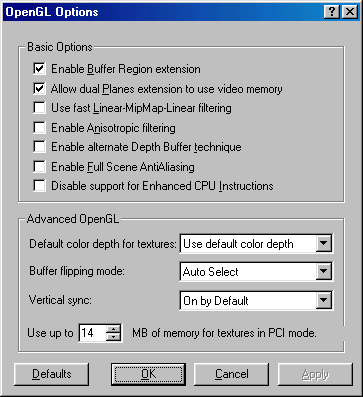
The OpenGL screen once again offers the same functionality as the reference
drivers.
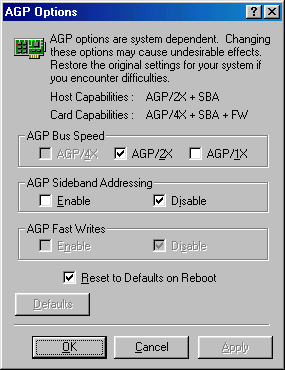
An interesting feature: An AGP option screen similar to the advanced options
of PowerStrip.
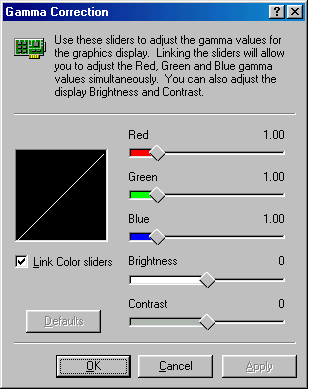
Color correction for the card.
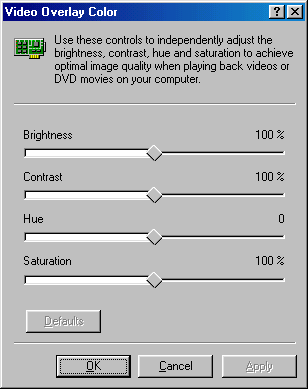
Video overlay screen for changing the quality of images from video playback.
The Drivers - 3D Blaster Control
In contrast to the FastTrax driver set, the 3D Blaster Control drivers are for those who are more concerned with interface and less concerned with constant driver updates. According to Creative Labs, the 3D Blaster Control driver are for users who are "concerned about [a] polished interface," and this is exactly what the 3D Blaster Control drivers provide: an elaborate display of video functions and features. The 3D Blaster Control drivers actually maintain the same functionality as the FastTrax drivers (meaning that it also contains the same functionality as the reference drivers) except in a very refined interface, one that is sometimes too elaborate.
While all the screens do look nice (a bit futuristic), some of the screens are hidden with buttons that blend into the interface. This makes the 3D Blaster Control drivers a bit hard to navigate, especially considering the fact that since the interface is "futuristic" of sorts some of the menus are not in the intuitive places. It is all just a matter of preference. If you like a simple, conventional driver set, the FastTrax drivers (described in the previous section) are for you. Those out there who are more into looks will prefer the 3D Blaster Control. Since Creative Labs packages the card with both driver sets and both driver sets are downloadable on Creative's web site, you are not limited to one driver or another. In addition, you can always still opt to use NVIDIA's Detonator drivers (the reference drivers).
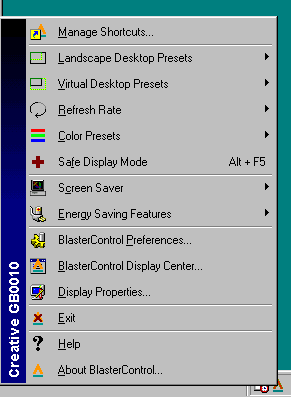
The taskbar resident utility provided access to common features.
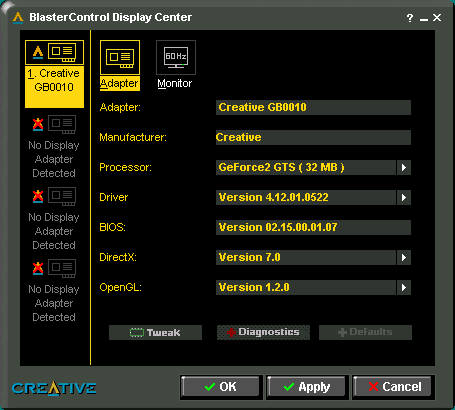
The main screen of the Blaster Control proved to be a bit confusing. Clicking
on the "Tweak" button revealed the features we were used to seeing.
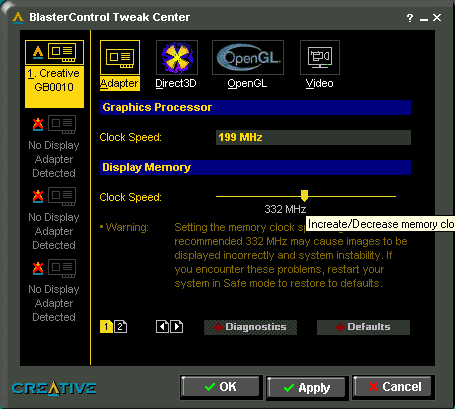
The Blaster Control program provided a similar overclocking too to the FastTrax
drivers, just with a different interface.
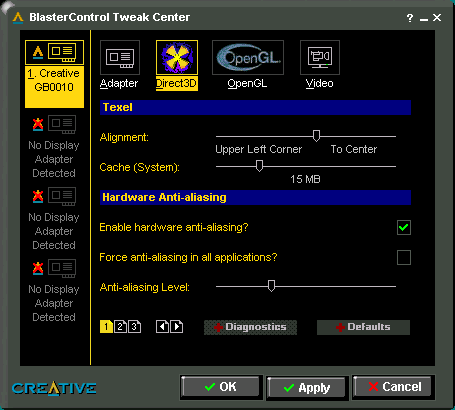
The D3D screen, with additional options on screens 2 and 3, selected by choosing
the page symbol at the bottom left.
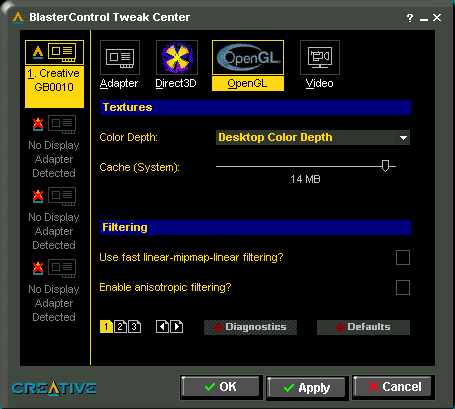
The OpenGL screen provided all standard features.
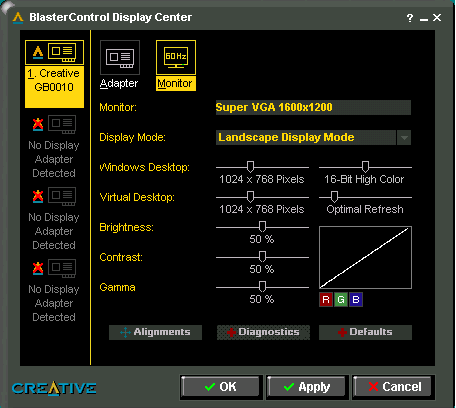
The monitor tab revealed a virtual desktop as well as color correcting.
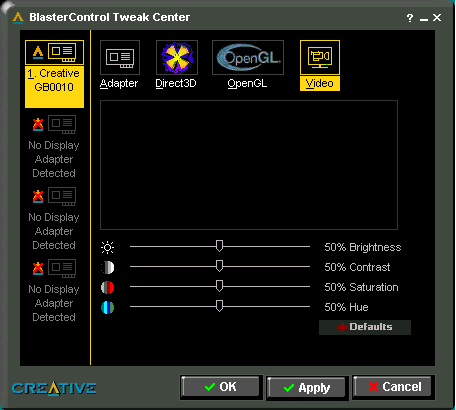
The video screen allows for tweaking of video playback colors.
The Test
|
|
Windows
98 SE Test System
|
|
|
Hardware
|
|
CPU(s) |
Intel Pentium III 750E |
| Motherboard(s) |
ABIT
BF6
|
| Memory |
128MB PC133 Crucial Technology SDRAM |
| Hard Drive |
Westen Digital Caviar 205AA 20GB UDMA 33 |
| CDROM |
Acer 24x |
| Video Card(s) |
Creative Labs 3D Blaster Annihilator 2 |
|
|
Software
|
|
Operating System |
Windows 98 SE |
| Video Drivers |
|
|
|
Benchmarking Applications
|
| Gaming |
GT
Interactive Unreal Tournament 4.04 UTbench.dem |
Quake III Arena Performance- demo001
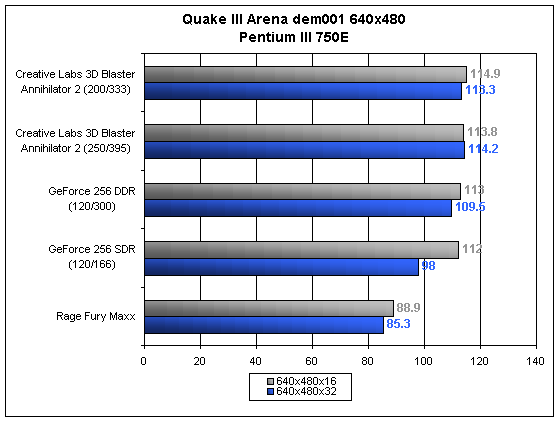
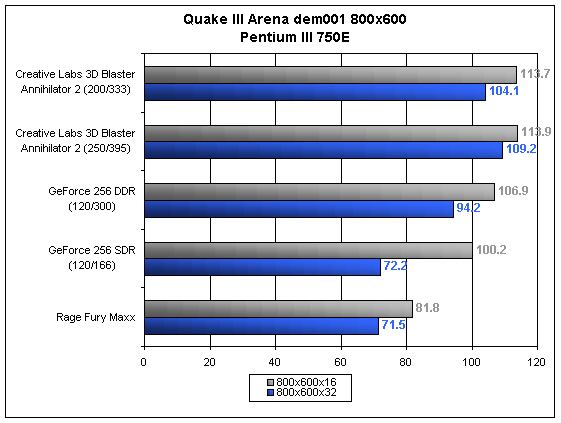
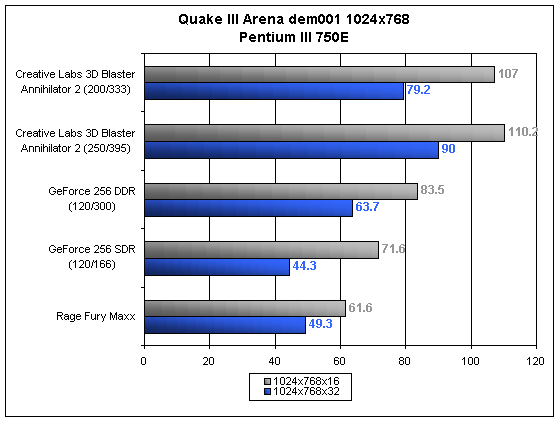
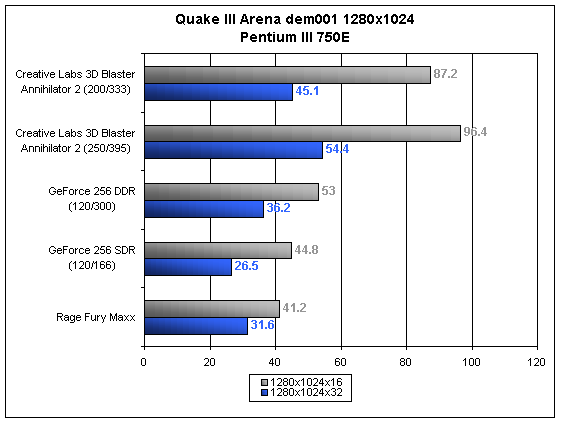
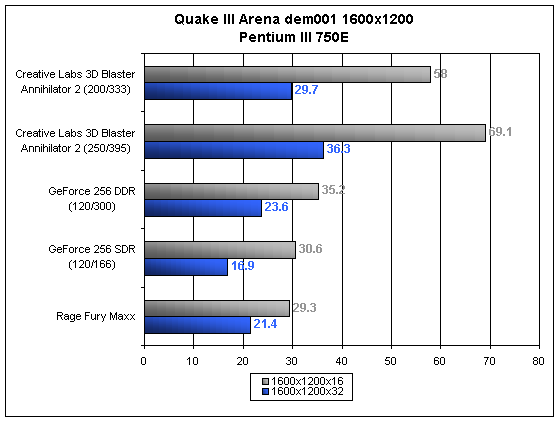
Using the default clock speeds, the 3D Blaster Annihilator 2 performed similarly to other GeForce 2 GTS cards, meaning that it was already on the top of the food chain. When overclocked, the speed associated with the GeForce 2 GTS only grew more. No longer were we limited by the speed associated with the fastest GPU currently available, but we were able to achieve a full 2 Gigatexels per second. Although the card, which performed 65% faster than the GeForce 256 DDR when at 1280x1024x16, did not see much improvement from overclocking at resolutions below 1024x768x32, at this resolution and above we were able to see where the speed of 2 Gigatexels per second and 395 MHz memory clock went.
When at the overclocked speed of 250/395, the Creative Labs 3D Blaster Annihilator 2 performed 22% faster than the normally clocked card when at 1600x1200x32, resulting in a frame rate of 36.3 FPS. This makes Quake III Arena playable (by some user's definition) at the very impressive and highly sought resolution of 1600x1200x32. At the more obtainable resolution of 1280x1024x32, the overclocked card was able to achieve 54.4 FPS, a 9.3 FPS speed increase over the normally clocked 3D Blaster Annihilator 2.
Quake III Arena Performance- Quaver
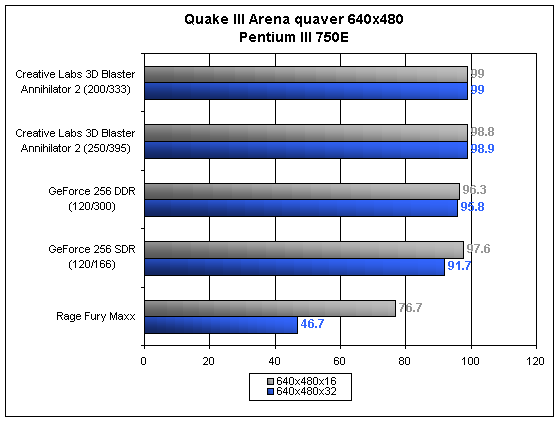
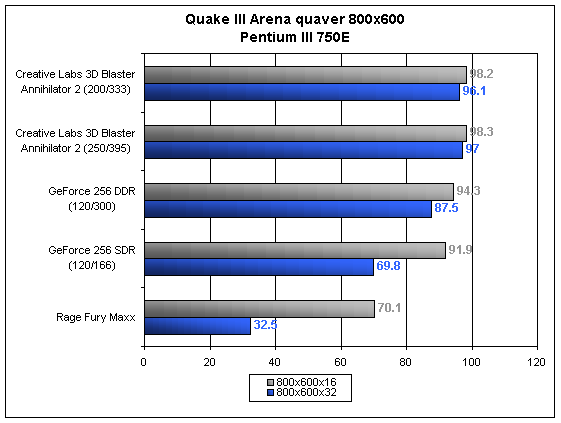
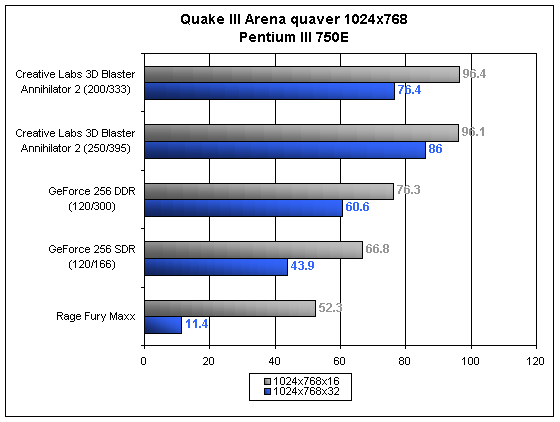
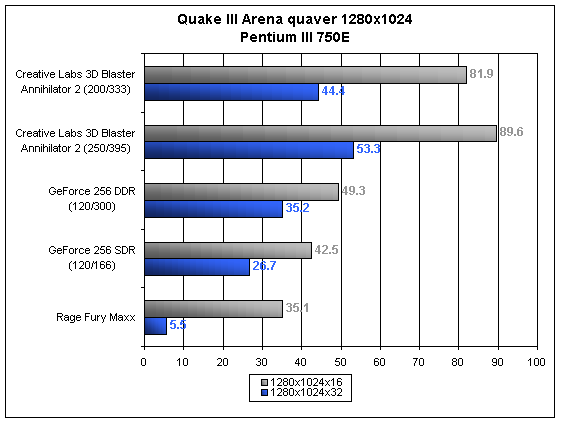
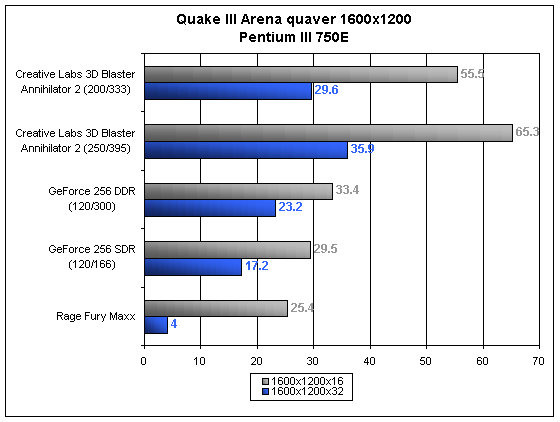
Ever since the introduction of NVIDIA's 5.xx driver set with S3TC compression, Quaver no longer stresses the GeForce series cards like it used to. Because texture swapping was all but eliminated due to the decreased size of the textures, the GeForce series cards respond very well to the texture intensive Quaver demo.
Once again, we find the 3D Blaster Annihilator 2 performing on par with other GeForce 2 GTS cards we have tested. The area where the card really shines is with the overclocked scores. The difference really does not become noticeable until 1024x768x32, where the Quake III engine stops acting as the limiting factor in the tests. At this resolution the overclocked card performed 9.6 FPS faster, for a resulting 12.5% speed increase. At 1280x1024x32, the 2 Gigatexel card was able to gain 8.9 FPS (20%) over the card running at 1.6 Gigatexel. Finally, we see once again that the almost unmentioned 1600x1200x32 resolution is actually becoming playable by many people's standards: at 35.9 FPS, the overclocked card beats the stock card 21.3% (6.3 FPS). Therefore, as one would suspect, the overclocked 3D Blaster Annihilator 2, with a 2 Gigatexel fill rate and a 395 MHz memory clock, takes the crown as the fastest GeForce 2 GTS ever seen at the AnandTech lab.
Unreal Tournament Performance
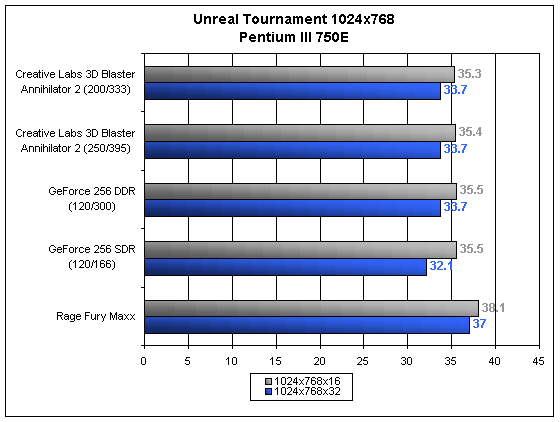
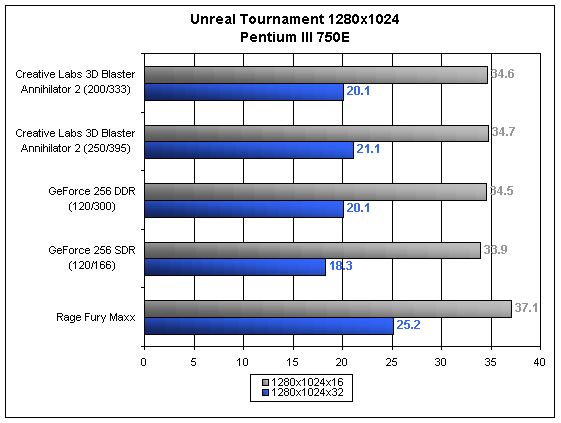
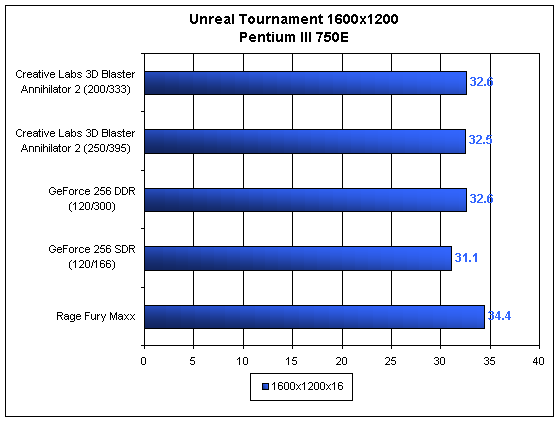
As our tests have shown time and time again, the Unreal engine was not created with such powerful video cards in mind. All cards, with the exception of the ATI Rage Fury Maxx, perform nearly identically. The game does not seem to particularly enjoy the speed gained from the blazing 250 MHz core speed: the FPS rating barely jumped at all. In fact, the maximum speed increase occurred at 1280x1024x32 and was only 1 FPS.
Conclusion
With such a dominating market presence, Creative Labs' products have always appealed to the masses. Creative does not only go after the hard core tweaker who is prone to mail order his/her video card, rather Creative Labs attempts to appeal to every consumer: newbie to techie. By having such a large market span (including mail order stores as well as retail locations), Creative Labs has the means to deliver a product to both types of consumers. The question is, does the 3D Blaster Annihilator 2 appeal to both? To answer this question, we must look at what the 3D Blaster Annihilator 2 has going for it.
The most important aspect of the 3D Blaster Annihilator 2 is the incredible price of the card. At a retail price of $299, the 3D Blaster Annihilator 2 undercuts the competition by $50. Although this price decrease may be a result of less eye candy on the card (no fancy heatsinks or tweaking tools), the Annihilator 2 is by no means an ordinary card. This was demonstrated by our ability to get to get the card to 250 MHz core and a resulting 2 Gigatexels per second. At such high speeds, only the highest quality components will survive, proving that the quality of the 3D Blaster Annihilator 2 is definitely above par.
You may be wondering if there are any other catches, besides the lack of additional features, to such a low priced card. The answer is yes, however the problem does not lie in the 2D resolution (as we have seen in the past). Instead, the problem lies with the software bundle, or, more specifically, the lack there of. In order to be able to sell the 3D Blaster Annihilator 2 at such low costs, it was necessary to pretty much kill any bundled games or applications. The 3D Blaster Annihilator 2 comes with little more than demos, as the package includes, LAVA (a "Music video player"), Media Ring Talk, Colorific, 3Deep, and the GeForce 2 GTS demo CD. All of these titles are not only unimpressive but they are also unnecessary. This is especially disappointing when we have seen many GeForce 2 GTS cards come with choose your own software bundles with impressive selections to choose from.
Besides this down point, does the Creative Labs 3D Blaster Annihilator 2 appeal to almost every user? The answer is yes. While the low price of the card may prompt other GeForce 2 GTS manufacturers to cut prices, it is unlikely that many cards will be able to compete with the price of the Annihilator 2 as those other cards pack in additional, and often times useless features that only increase cost. By keeping it simple, Creative Labs was able to manufacture a winner as well as "AnandTech's First 2 Gigatexel Game Accelerator."
How It Rates
Please note that the score given is a comparison between the Creative Labs 3D Blaster Annihilator 2 and other GeForce 2 GTS cards on the market. This is not meant to reflect how GeForce 2 GTS cards compare to other video cards on the market processor wise. To find this information, please see our NVIDIA GeForce 2 GTS review. Also keep in mind that a score of five indicates standard performance. To learn more about our rating system, please click here.
|
AnandTech Video Card Rating |
|
|
Rating
(x/10)
|
|
|
Performance
|
7.0
|
|
Price
|
8.0
|
|
Drivers
|
7.5
|
|
Features
|
3.5
|
|
Retail Availability
|
9.0
|
|
Documentation & Software Bundle
|
5.0
|
| Overall Rating |
8.0
|
Note: The Overall Rating is not an average of all of the categories

